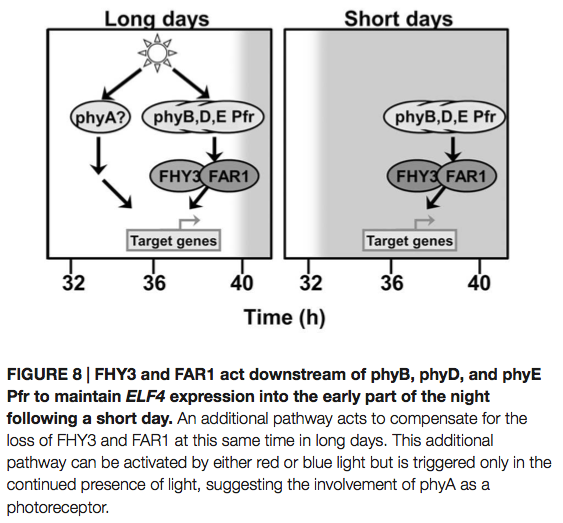This weeks Arabidopsis Research Roundup includes three papers from the Norwich Research Park on very different topics. Firstly the team of Richard Morris investigates the nature of mRNA sequences that are transported over long-distances. Secondly Kristen Bomblies introduces a set of genes involved in the evolution of weediness whilst finally Cyril Zipfel is involved in research that developed a novel assay for identification of defence signaling components. Elsewhere Paul Devlin’s group from RHUL characterises the interactions between components of a light signaling pathway whilst Alex Webb and co-workers use a novel assay to confirm the activity of plant nucleotide cyclases involved in calcium signaling.
Calderwood A, Kopriva S, Morris RJ (2016) Transcript abundance explains mRNA mobility data in Arabidopsis thaliana. Plant Cell http://dx.doi.org/10.1105/tpc.15.00956 Open Access
Richard Morris (JIC) is the lead author on this ‘Breakthrough Report’ that analyses previously generated data in order to ascertain whether populations of mRNAs that are transported long-distances in the phloem are selected by any mechanism. They showed that in general mobile transcripts can be explained by their abundance and half-life, leading to the conclusion that the majority of transported mRNAs are not selected on the basis of their primary sequence.
Baduel P, Arnold B, Weisman CM, Hunter B, Bomblies K (2016) HABITAT-ASSOCIATED LIFE HISTORY AND STRESS-TOLERANCE VARIATION IN ARABIDOPSIS ARENOSA Plant Physiol. http://dx.doi.org/10.1104/pp.15.01875 Open Access
Recent ECR Research Grant awardee Kristen Bomblies (JIC) leads this investigation into growth variation in Arabidopsis Arenosa. This obligate outbreeding relative of A.thaliana is normally not weedy but can transition to weediness in conditions of high disturbance. This study uses transcriptome sequencing, genome resequencing scans for selection, and stress tolerance assays to investigate a weedy population of A.arenosa that has been discovered growing along railway lines through central and Northern Europe. These plants show constitutive upregulation of genes involved in heat shock and freezing tolerance. Amongst the genes that were strongly selected in the weedy population was LATE ELONGATED HYPOCOTYL (LHY), which is known to regulate many stress-regulated genes in A.thaliana and therefore might be a significant determinant in the evolution of weediness.
Saur IM, Kadota Y, Sklenar J, Holton NJ, Smakowska E, Belkhadir Y, Zipfel C, Rathjen JP (2016) NbCSPR underlies age-dependent immune responses to bacterial cold shock protein in Nicotiana benthamiana Proc Natl Acad Sci U S A. http://dx.doi.org/10.1073/pnas.15118471
This Australian-Austrian-UK collaboration includes work from the lab of Cyril Zipfel (TSL). The initial work in this study uses the Nicotiana benthamiana expression system to identify novel leucine-rich repeat (LRR)-containing pattern recognition receptors (PRR) that interact with the BRI1-ASSOCIATED KINASE1 (BAK1) protein, which is important in recognition of bacterial pathogens. N.benthamiana plants were treated with the effector peptide csp22 and the resulting samples were immunopurified with BAK1. They identified a protein termed RECEPTOR-LIKE PROTEIN REQUIRED FOR CSP22 RESPONSIVENESS (NbCSPR) which, when silenced in tobacco resulted in reduced defence responses to the csp22 peptide. Subsequent expression of NbCSPR in Arabidopsis caused antibacterial resistance. Primarily the authors demonstrate a novel protocol that could be used to identify further novel components in signaling pathways that response to pathogen attack.
Siddiqui H, Khan S, Rhodes BM, Devlin PF (2016) FHY3 and FAR1 Act Downstream of Light Stable Phytochromes Front Plant Sci. 7:175 http://dx.doi.org/10.3389/fpls.2016.00175 Open Access

Paul Devlin (RHUL) is the lead on this study that looks at the regulation of the ELF4 gene. This gene is a light-dependent target for the transcription factors FHY3 and FAR1 and the authors demonstrate that this signaling acts via not only the phytochrome PhyA but also through phyB, phyD, and phyE. ELF4 induction by FHY3 and FAR1 occurs specifically in the evening, which allows expression of ELF4 beyond dusk during shortening days. Without the action of the two transcription factors, this ELF4 expression is not maintained resulting in further downstream gene expression changes that alters the cycling of the circadian clock.
Abdul-Awal SM, Hotta CT, Dodd AN, Davey MP, Smith AG, Webb AA (2016) NO-mediated [Ca2+]cyt increases depend on ADP-ribosyl cyclase activity in Arabidopsis Plant Physiol. http://dx.doi.org/10.1104/pp.15.01965 Open Access
This study continues Alex Webb’s (Cambridge) work in the area of calcium signaling by investigating the control of cyclic ADP-ribose (cADPR) production in Arabidopsis. Although the role of cADPR in plant signaling is well established there are no ADPR cyclase enzymes with strong similarity to known metazoan enzymes in previously interrogated plant genomes. This argues for either a unique synthesis route for cADPR or for the activity of an enzyme with low sequence similarity to previously characterized cyclases. To test these difference ideas the authors developed two novel fluorescence-based assays to measure ADPR cyclase activity. These assays reveal that indeed there is activity that resembles the characteristics of a cyclase, which additionally is activated by nitric oxide (NO). This potentially links NO signaling activity to increased levels of cADPR and mobilisation of a calcium signal.












